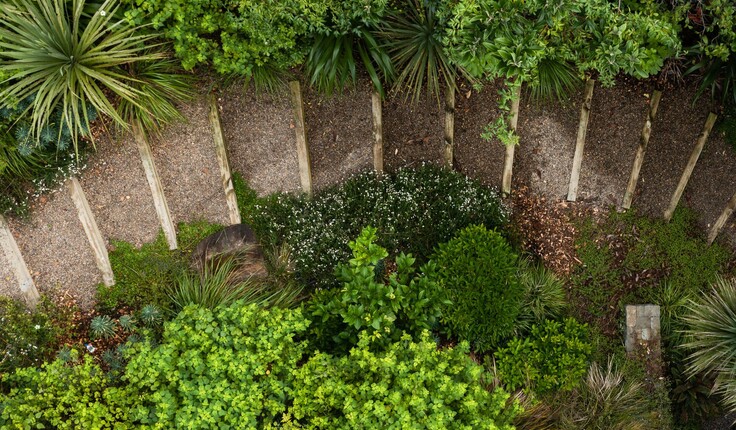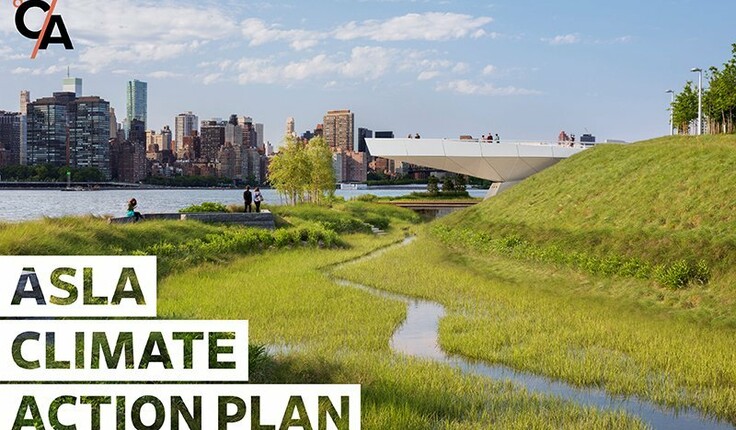News
WLA 2023 Landscape Architecture Trends
Posted 18 01 2023
in News

Written by Damian Holmes, Founder & Editor of World Landscape Architecture (WLA) and republished with permission
The coming year has a greater sense of optimism after the past three years of COVID-19; there are possible economic issues in 2023; however, the landscape architecture profession will continue to move forward and lead projects. Many trends will occur over the coming 12-24 months, and I seek to address the main 2023 trends that will influence the landscape architecture profession.
Climate change will have an increased influence on design firms
As governments, clients and organisations have moved from discussing and debating climate change over the past decade to supporting various initiatives through financial support and procurement requirements. Landscape architects will continue to address various problems (flooding, drought, biodiversity decline, heat island effect, and many others) with solutions based on science, art and nature.
Professional organisations such as ASLA, AILA, Landscape Institute and others are providing policies and tools for landscape architects to assist in reducing or eliminating carbon emissions (operations and projects) from their projects. These organisations are also pushing landscape firms forward by running education programs and including sustainability criteria in award programs.
Clients (Public and Private companies) will place more significant requirements on consultants to reduce emissions to comply with their company action plans and ESG policies. These requirements will come in different forms, with design firms needing to show that they have environmental credentials (carbon offsetting, policies, etc) in operating their company, and they will also have to provide data or certification that the design for the project will achieve reduced emissions or carbon sequestration in comparison to baseline designs.
Addressing climate change will not be limited to environmental issues. Over the past few years, it has been apparent that there is a need to address social issues related to justice, equity, diversity and inclusion within communities, design firms and governments. Landscape architects will need to be part of the conversation and look to lead it when possible in 2023.
Natural and Engineering solutions
Due to the tight time program, many governments have realised that natural solutions alone (reforestation, wetland creation, mangrove reinstatement, etc.) will not be able to reach their 2030 goals or targets. Therefore they will increase budgets for engineering and technical solutions (batteries, alternative energy systems, carbon capture, etc.) to reduce carbon emissions. These technological initiatives will involve landscape architects during urban design, and planning phases as governments (and private companies) seek to determine the best locations (through GIS etc.) for these initiatives.
A shift in focus from emissions to biodiversity
Due to the Biodiversity Agreement reached at the COP15 UN biodiversity summit in Montreal, Canada and other government policies, the focus will shift from carbon emissions to other climate change issues such as biodiversity, greenhouse gases and water/food security. Landscape architects will start to see clients require more information about how projects are contributing to improving biodiversity and reducing emissions within projects. There will be a move from monoculture urban forests planted to achieve carbon offsets to greater species diversity of plantings to achieve increased biodiversity. This trend will impact nurseries as there may be a significant increase in contract growing, including sourcing seed and developing propagation techniques to grow some species at scale commercially.
Evidence-Based Design
Evidence-Based Design (or data-driven design) was highlighted in my 2022 trend predictions, including Climate Positive Design and Carbon Conscience App tools. These tools will go from “nice to have” on projects to becoming more commonplace in design firms as they seek to improve designs and provide clients with data or indicators that show carbon reduction or sequestration values. This trend will also see other simpler tools develop as many firms find that they do not have the time (or fees) to compile and analyse the numbers for large and small-scale projects.
A future trend in 2025-2027 will be design firms undertaking Post Occupancy evaluations (POE) on projects using the Climate Positive Design and Carbon Conscience App tools. These POE exercises will determine if the original design and calculations perform as intended. There will be mixed results based on construction and maintenance quality.
Mapping
The landscape industry has used GIS for many years to undertake Environmental Assessments and planning for various developments (buildings, wind turbines, etc). In 2023 we will see an increase in the use of mapping tools such as GIS to develop data-based time-based visualisations for clients and stakeholders to understand the context and possible impacts of climate change and disasters. GIS will also be utilised for improvement projects such as urban forests, and coastal protection and mitigation projects. GIS data visualisations are already being used at the federal and state levels in the USA, such as FEMA Risk Rating 2.0 and CPRA Spatial Viewer.
BIM and Digital Twins
BIM is no longer a trend. It is part of many landscape architecture firms’ daily design workflow. There is an increasing requirement for landscape architects to use BIM when working with cities, allied professionals, contractors, and facilities managers. Often that requirement includes updated construction models and “as built” confederated models that need to be submitted to clients for facilities management. These requirements can be time-consuming and require firms to charge more fees for the completion phase of the project.
Digital Twins (DT) are becoming more common due to client requirements and the lower costs of tools and apps that can utilise drone footage and LiDAR/TOF Scanning (iPhones, Andriod) in conjunction with spatial data available from various sources, including city planning departments. Digital Twins are useful for visualising changes in urban planning, inventory of existing buildings and assets, and management of assets (maintenance scheduling, etc). These models can be used to manage cities in real time and provide predictive models due to climate change, increased/reduced transport usage, biomass and more.
The design industry is still burdened with the misunderstanding of what digital twins are and are not. This will change over time, but similarly, when BIM started to emerge, it will take some time to educate clients and other professionals on what landscape architects can achieve in producing and using Digital Twins.
Artificial Intelligence (AI)
Over the past few years, Artificial Intelligence (for this discussion includes AI, Machine Learning, etc) have quickly moved from ideas to tools, including image generation (midjourney, DALL-E, etc), text generation (chatGPT,) terrain modelling, urban forest inventories, design reiteration, and more. This trend will assist landscape architects and many other professions as they move from using manual or semi-automated tools with multiple workflows and scripts to highly-automated tools that can test design options and provide analyse to inform better design.
There are various issues that the profession will face concerning AI, including ethics, design declarations and accreditation. Hopefully, these issues will not stall the adoption of AI technology that can dramatically assist landscape architects in designing and developing solutions for the world’s problems. We will see more apps and tools developed by OpenAI and other AI companies over the coming year.


Beyond Boundaries
Many governments realise they cannot successfully achieve their climate change initiatives without collaborating with other governments. Whether at a local, state/provincial or national level, it is becoming apparent that governments need to look beyond their geopolitical borders and reach agreements with multiple governments to have a greater impact on climate change. Agreements such as the recent agreement between the water authorities on the Colorado River Basin to fund non-functional turf replacement with a more water-efficient landscape will become more common in 2023.
Post COVID focus on cities cores and open spaces
COVID and Flexible working have seen a decline in the visitation and vitality of central cores of cities. Business groups (Real Estate developers & operators) are pressuring city governments to attract people back to central areas with short-term initiatives such as events, free parking, cash incentives, making temporary dining permanent and pedestrianising streets.
City governments need to plan to attract people and businesses back to city cores; this has started to occur with cities creating master plans or action plans to look to solve the issues they now face. The New York City & New York State governments recently released the Making New York Work for Everyone action plan. Their action plan seeks to reduce commute times, increase mixed-use, change planning regulations to free up underutilized buildings, and increase major public realm interventions (pedestrianisation, greens spaces). More cities will create action plans to attract people and reduce the pressure they feel from commercial realtors. There is an ongoing discussion of converting office buildings to residential; however, this can be costly and requires market demand for more apartment/condo living.
People over the past two years have increasingly used open spaces as they realised the value of outdoor living during COVID. They seek to be outdoors during warmer months and look to parks, waterways, bike paths and team sports to enjoy life and meet up with friends and family. This increased usage will have several impacts on landscape architects as cities need to balance creating more inviting spaces whilst maintaining existing and creating new spaces.
Energy – systems and charging
As the prices of grid-based energy increase, schools, resort operators, and shopping centre managers will shift to seek out alternative energy systems (solar/wind) for their sites as they seek to reduce costs and seek out alternative energy solutions as prices for solar have declined over recent years. This is dependent on site location (sunshine hours, wind). However, landscape architects may see that they are required to determine the best locations for solar arrays or wind on project sites.
Due to increasing electric car sales there will be increased need for charging networks on streets, highways, shopping/dining precincts and transport hubs (airports/train stations). In some cities the demand will be greater due to the introduction of Traffic Zones (Congestion, Low & Zero), bans on fossil fuel cars (by 2035), and manufacturers increasing the electric models available. For landscape architects, it will require learning more about the various regulations and requirements (setbacks, cabling, etc) for charging networks (posts, stations, transformers, etc) and also working with cities (and private companies) on the sensitive placement of charging infrastructure.
Residential – more entertaining, less lawn and more on-site energy
Various factors, including less risk around COVID, inflation and a possible recession, may see more people wishing to entertain at home during 2023. Thus increasing the current trend of outdoor seating areas, kitchens, BBQs, and lighting to allow people to entertain family and friends.
As local governments seek to manage water (irrigation and catchment), we will see a reduction in lawn areas due to government initiatives. In turn, this will create more xeriscaping and requests for more efficient irrigation. In some areas, governments will increase the requirements for residences to store or detain rainwater on their site rather than allowing it to instantly flow to city stormwater systems. These requirements will increase the use of rain gardens, water tanks and other temporary storage in residential landscapes.
Some people will look to reduce their energy costs due to rising prices. This may include rooftop or on-ground solar or mini wind turbines in conjunction with battery arrays located in the landscape. Also, as more people purchase electric cars, they may wish to have a charging port or station in their yard.
Education
Most universities are back teaching in-person classes, and international students move freely due to reduced border controls. This is beneficial for students as learning in an in-person environment is more conducive to teaching and learning. Also, it allows students to collaborate in person with their future colleagues and allied professionals in other departments.
During COVID, many universities changed their lectures and seminars to virtual events (for free); however, as they have returned to the classrooms and lecture theatres there have been fewer virtual events. I hope this trend can be reversed.
Flexibility in working
During COVID, many employers moved to remote working and employed people in other cities and countries to work remotely. Many employers have found this beneficial for their companies during the skills shortage; however, some firms have found it difficult to collaborate or retain remote workers as the fear of COVID dissipates, and the idea of permanent remote working is not as expected.
Employers and employees in design firms have come to realise that collaboration in person is undervalued and that working together in the same space is often more dynamic and conducive to collaboration and ideation. Also, many remote working employees (in cities differing from the office) have looked for local work to feel that human connection and part of a team. Although remote working is not dead, workplaces have determined that they can be more flexible to achieve a more balanced work-life through flexible hours and regular or occasional working from home. This change is also to retain employees during the current tight employment market (which may change in the coming year).
Landscape Architects Shortage
The shortage of landscape architects has continued for the past 3-5 years as they are in greater demand for landscape firms to lead projects, and governments are spending more money on city-changing projects. However, various economic indicators show a possible recession and increased financing costs for public and private projects. In turn, a recession means fewer new projects, projects put on slowdown or hold as clients seek to wait until the economic outlook is more stable. Therefore, the shortage may be reduced in 2023 due to economic changes.
Moving through 2023
As we move into 2023, there is a sense of expectation and positive energy that we have moved beyond COVID; we can move forward to address the various issues facing our industry and the world. At the same time, there is some apprehension about the possibility of a financial recession in 2023. However, we have learnt over the past three years that we are resilient, that anything we face is surmountable, and that we can come together in bad times to work through problems and achieve great things. I hope you have enjoyed reading this year’s trends article and that you are inspired to explore these ideas and trends in 2023.
DISCLAIMER: This article is for educational purposes only. The content is intended only to provide a summary and general overview of matters of interest. It’s not intended to be comprehensive nor to constitute advice. You should always obtain professional advice appropriate to your circumstances, before acting or relying on any of that content. This advice is general in nature.
Share
19 Dec
Christmas break 2025

see you from 12 January
As we wrap up another big year, we’re taking a moment to pause, breathe, and enjoy a well-earned break. Meri …
18 Dec
President’s update

December 2025
Earlier this month I attended the Ngā Aho Māori Design Professionals Wānanga-ā-Tau at Te Aranga Marae in Flaxmere. Tuia Pito …
18 Dec
Awards 2026 update

An update as we warm up for the 2026 Awards kaupapa. Submissions will open in March and will run for …
Events calendar
Full 2026 calendar